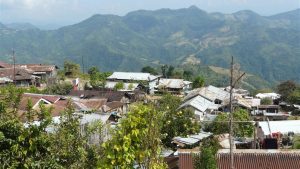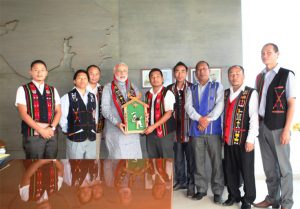Indo-Naga Political Negotiations: An Explainer
Written by Abhishek Chakravarty
7 min read

Formation of the Naga Identity
“Nagas have a unique history and identity,” expressed Mr. Thuingaleng Muivah, one of the top leaders of the Naga separatist movement, in a recent interview to a popular Indian web-based news platform. The Nagas take immense pride in asserting this unique identity and culture, which includes their traditional rituals, dances, attires, hunting traditions, and the fierce independent nature of the tribes.
Given this history, the collective Naga identity is relatively new. In the 19th century, American Baptist missionaries introduced Western religion and education to the Naga Hills. The missionary education of young Nagas instilled a sense of nationalism and collective identity. This generation spread the idea of a nationalist Naga identity based on cultural commonalities across tribes and Christian faith, unifying the Naga people and instilling peace between the warring tribes. The genesis of the Naga separatist movement grew out of this emerging sense of a collective Naga identity, which stood in conflict to their forced assimilation into the Indian state.
Today the Naga designation includes more than four million people that are members of over 30 tribes living across the states of Nagaland, Assam, Arunachal Pradesh, and Manipur in India and the Kachin State and Saigaing Division of Myanmar. Naga separatists claim these 120,000 square kilometers of hilly territory as the Nagalim, or the sovereign Naga homeland.
Since India’s independence more than half a century ago, neither the Naga separatists nor the Indian central government have been willing to compromise on the Naga claim to a sovereign homeland. The two groups have been ensnared in an ongoing conflict for eight decades, a conflict whose protracted nature has a long history and whose resolution remains stagnant.
Naga Nationalism Consolidates
Following the cultural shift brought about by Christian missionary work, Naga national identity consolidated during World War I when about 2000 Nagas, belonging to different tribes, were enlisted in the British Indian Army. Fighting together, rather than against each other as they did back home, further strengthened their sense of commonality. Many of these veterans came back and formed the Naga Club, one of the first pan-Naga organizations.
The Naga Club became a unified representative body for all the Naga tribes, representing the Naga people’s desire to remain as an autonomous unit under British control, rather than Indian governance, to the Simon Commission in 1928. The Naga Club, transformed into the Naga National Council (NNC) lead by hardliner Angami Zapu Phizo, declared independence on August 14, 1947, a day before India’s independence.
Since India’s independence more than half a century ago, neither the Naga separatists nor the Indian central government have been willing to compromise on the Naga claim to a sovereign homeland.Post-independence, the Indian government adopted policies for governing Nagaland that had parallels with the colonial British government’s approach. First, Nagaland fell under the Sixth Schedule of the Indian Constitution, which included an excluded areas and partially excluded areas policy. Later, through the 1962 13th Amendment Act, Nagaland fell under Article 371A of the Indian Constitution, according to which the Nagas were granted a degree of autonomy over their land and preserved local laws and practices. Yet Naga leaders were not satisfied with these provisions, demanding greater independence, a separate flag, and their own constitution. With neither side willing to concede much ground, the Naga leadership’s negotiations with Prime Minister Jawaharlal Nehru ended in a stalemate. As a result, the region experienced significant unrest—protests originating in villages against the Indian state—and many boycotted both the General Elections and Assam Assembly Elections. On March 22, 1952, Phizo formed the underground Naga Federal Government (NFG) and the Naga Federal Army (NFA).1 A History of Conflict and Failed Peace Agreements Due to prolonged unrest, the Indian government declared Naga Hills District a “Disturbed Area” under the Assam Disturbed Areas Act of 1955. Later in 1958, the draconian Armed Forces Special Powers Act also came into effect. Both pieces of legislation gave unrestrained powers to the military to subdue the Naga separatist movement. This intensified the conflict further, since both sides suffered casualties as the Nagas retaliated against the military atrocities.2
 In an attempt to come to a compromise, the Indian Government declared the Naga Hills district a state under the Indian Union in 1963, thus giving greater powers to the state government. However, this move did not change Naga demands for independence and strife persisted. After another decade of violent conflict, the NNC signed a peace agreement in 1975 called the Shillong Accord.
But this sense of consensus was shattered when the rebel leaders who rejected the Shillong Accord formed a new organization called the Nationalist Socialist Council of Nagaland (NSCN). For the next two decades, another fresh wave of violence erupted in the region.3 There was an attempt on the life of S.C. Jamir, the then Chief Minister of Nagaland. Following this were several ambushes on the security forces and public leaders in the State.4 Since mid-1992, the NSCN-IM shifted its area of operation with a series of violent attacks in the tea gardens of Assam along the Assam-Nagaland border. And, in the Karbi Anglong and the North Cachar Hills districts of Assam, the NSCN-IM and its front organizations launched a massive extortion drive targeting businessmen, government and bank employees. The campaign reached such an intensity that banks operating in the area began contemplating withdrawal.5
Again, as a consequence of another ceasefire agreement in 1997, the NSCN split into multiple factions, each with their own objectives and interpretation of the ceasefire agreement. While war between these factions once again stymied the negotiation process, common Naga citizens began to slowly assimilate with Indian society as many dispersed throughout India for work and education. By the early 2000s, Naga society was divided into those who pledged their allegiance to a separatist faction or those who supported the Indian government.
In an attempt to come to a compromise, the Indian Government declared the Naga Hills district a state under the Indian Union in 1963, thus giving greater powers to the state government. However, this move did not change Naga demands for independence and strife persisted. After another decade of violent conflict, the NNC signed a peace agreement in 1975 called the Shillong Accord.
But this sense of consensus was shattered when the rebel leaders who rejected the Shillong Accord formed a new organization called the Nationalist Socialist Council of Nagaland (NSCN). For the next two decades, another fresh wave of violence erupted in the region.3 There was an attempt on the life of S.C. Jamir, the then Chief Minister of Nagaland. Following this were several ambushes on the security forces and public leaders in the State.4 Since mid-1992, the NSCN-IM shifted its area of operation with a series of violent attacks in the tea gardens of Assam along the Assam-Nagaland border. And, in the Karbi Anglong and the North Cachar Hills districts of Assam, the NSCN-IM and its front organizations launched a massive extortion drive targeting businessmen, government and bank employees. The campaign reached such an intensity that banks operating in the area began contemplating withdrawal.5
Again, as a consequence of another ceasefire agreement in 1997, the NSCN split into multiple factions, each with their own objectives and interpretation of the ceasefire agreement. While war between these factions once again stymied the negotiation process, common Naga citizens began to slowly assimilate with Indian society as many dispersed throughout India for work and education. By the early 2000s, Naga society was divided into those who pledged their allegiance to a separatist faction or those who supported the Indian government.
The Naga separatists are steadfast in their demands for a separate constitution alongside a flag, an issue about which the Indian Government harbors reservations.The Indian government, on the other hand, has always taken a strong non-negotiable stance on issues relating to sovereignty. It has from time to time dealt sternly with all insurgency movements that demanded sovereignty from the Indian state, either through repression or by way of granting statehood within the country.6 The Latest Peace Agreement On August 3, 2015, the Indian government and the NSCN signed an agreement to end the insurgency and come to a peaceful solution. Prime Minister Narendra Modi termed the agreement—signed after 80 rounds of talks with the various stakeholders to the conflict—“historic.” The agreement was seen as a step toward sharing sovereign power between the Indian State and the Naga people and a move towards a more inclusive and peaceful coexistence. Nonetheless, the process remains in another deadlock. The Naga separatists are steadfast in their demands for a separate constitution alongside a flag, an issue about which the Indian Government harbors reservations. The issue of shared sovereignty also remains unclear, especially with regards to how authorities will actually divide their sovereignty in practice. At present, there are still several factions of the NSCN and many other social organizations that are not aligned with the signatories of the agreement. Given the movement’s long history of factional breakdowns over ceasefire agreements, this may signal potential future conflict. Remaining Questions After more than seven decades of armed struggle and conflict, most Nagas have become averse to violence. Many young Nagas are assimilating into mainstream Indian society, some several thousand even joining the Indian armed forces. Many Indian nationalist political parties have also made inroads into Nagaland and have succeeded in electing members to the local state assembly. At this point, several questions arise, the first being: whose war are the separatist factions really fighting? Second, while the Indian Government pushes for a “one land, one people, one law” policy and has shown its resolve to abolish Article 370 in Jammu and Kashmir, how likely is it that the Indian state will ever fully accommodate the aspirations of the Naga people on the issue of shared sovereignty? Last, many Naga tribes live across India’s border with Myanmar, from where several rebel camps also operate. For this reason, Myanmar may be a necessary part of finally resolving the Naga conflict. But what could compel India to agree to involve Myanmar on an issue which it considers a sovereign internal matter?
